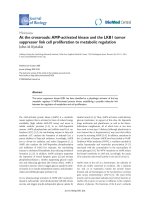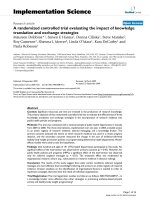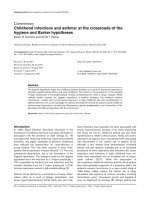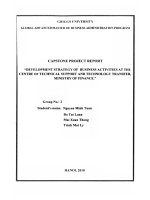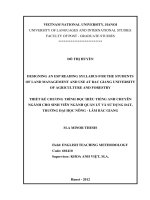At the crossroads of knowledge management and social software
Bạn đang xem bản rút gọn của tài liệu. Xem và tải ngay bản đầy đủ của tài liệu tại đây (270.27 KB, 10 trang )
At the Crossroads of Knowledge Management and Social
Software
Gabriela Avram
Interaction Design Centre, University of Limerick, Ireland
Abstract: The growing phenomenon of Social Software seems to provide an opportunity to complement the top-down
approach based on central knowledge repositories with tools that are simpler, smarter and more flexible. This article includes a brief description of the main categories of Social Software – weblogs, wikis and social networking sites - followed by an analysis of their utilisation in relation to the five core Knowledge Management activities of the Knowledge
Management taxonomy proposed by Despres & Chauvel in 1999. Examples that illustrate the support Social Software
could provide for knowledge management are presented. Finally, some of the problems that hinder the usage of Social
Software tools, together with some of the latest developments and trends in the field are mentioned.
Keywords: Social Software, weblog, wiki, social networks, knowledge acquisition, knowledge sharing.
– such as weblogs, wikis, social networking sites,
social tagging, events management, geo tagging.
Probably the specific tools, permanently evolving,
are not as important as the social phenomenon
generated around them – through spontaneous
interaction, pro-active attitudes, enhanced knowledge creation, knowledge sharing and transfer.
1. Introduction
Knowledge Management (KM) and collaboration
are considered to be pre-requisites for more innovation and enhanced creativity. Until recently, most
of the KM efforts were focused on the creation of
central knowledge repositories, encouraging
knowledge reuse and collaboration based on these
repositories, in a typical top-down approach where
knowledge was seen as a separate entity. The
growing phenomenon of Social Software offers a
chance to complement this approach with tools
that are simpler and more flexible. This type of
software is actually not new at all – software applications having similar traits have been in use for
quite some time – but it is only recently that these
have been labelled as “Social Software”. Social
Software is the term used to designate, “the use of
computing tools to support, extend, or derive
added value from social activity - Including (but not
limited to) weblogs, instant messaging, music and
photo sharing, mailing lists and message boards,
and online social networking tools” (Lawley 2004).
Section 3 contains an analysis of three important
categories of Social Software (weblogs, wikis and
social networking) in connection with the core KM
activities included in the taxonomy of applied
Knowledge Management proposed by Despres
and Chauvel (1999).
Several examples extracted from different sources
presented in section 4 are meant to illustrate the
various ways in which Social Software is able to
support knowledge management.
Section 5 considers some of the problems that hinder the usage of Social Software tools and points
to some of the latest developments and trends in
the field.
What could Social Software do for Knowledge
Management? Knowledge emerges in conversations, actionable knowledge is mainly the result of
collaboration, and more and more importance is
given to social capital. Social Software provides
the necessary support for conversations and collaboration, for knowledge creation, sharing and
publication, for identifying experts and getting access to expert opinions worldwide. It leaves the
control of knowledge with the individuals owning it.
Each individual is able to maintain his own space
for which he has complete control over the information he chooses to share. This creates a bottom-up style of information sharing and collaboration, rather than an imposed or corporate top-down
strategy. (Fisher 2005)
2. Social software
What types of software are actually included in the
category of Social Software? There is a tendency
to include email, discussion lists or message
boards under the umbrella of Social Software. And
to a certain degree, they are social interaction tools
too. But there’s an important distinction between
traditional communication software - forming people into groups with a top-down approach and assigning membership, as discussion lists and forums usually do, and Social Software - with its bottom-up approach, enabling people to organize
themselves into a network based on their preferences (Boyd 2005).
According to Stowe Boyd, social software encompasses one or more (though not necessarily all) of
the following elements
The second section of this paper includes a brief
description of the various types of Social Software
ISSN 1479-4411
1
©Academic Conferences Ltd
Reference this paper as: Avram, G (2006) “At the Crossroads of Knowledge Management and Social Software” The
Electronic Journal of Knowledge Management Volume 4 Issue 1, pp 1-10, available online at www.ejkm.com
Electronic Journal of Knowledge Management Volume 4 Issue 1 2006 (1-10)
Support for conversational interaction between
people or groups. That includes real time conversations like instant messaging, and what
Boyd calls “slow time” conversations that occur
in collaborative virtual spaces.
Support for social feedback. Reputation and trust
are crucial in online interactions, as demonstrated by the importance placed by sites such
as eBay on a seller’s rating and reputation.
Support for social networks. Many Social Software
applications create a digital layout of a person’s social network and facilitate adding new
connections. (Kaplan 2005):
The sudden popularity of social technologies is
attributed to the increase in low-cost tools and the
critical mass of millions of people who are now
connected to the Internet (Boyd 2005), to the growing tendency of people to rely more on their own
personal social networks than on traditional company structures (Nardi 2004), and to the people’s
need to feel part of a community (Bryant 2003).
Jack Vinson depicts other characteristics of Social
Software tools: they are extremely easy to use;
they provide for networking and allow for selfforming networks; usually, readers are also contributors and vice versa, this virtual environment
enforcing much less sense of hierarchy than in the
real world; relationships become nothing but flows
– one person can be at the same time part of several networks (Vinson 2005).
The key areas of Social Software are considered
to be the weblogs, the wikis, and the social network services of different kinds (Boyd 2003). Social network services range from some focused
purely on networking, to others designed to share
different types of resources, or meant for open coordination purposes (Figure 1). A strict classification is hard to derive, because the categories of
Social Software tend to intertwine and to rely on
each other.
Figure 1: Key areas of Social software
permalink (permanent URL), which is usually
automatically generated by all popular weblog systems.
2.1 Weblogs
A weblog or simply a blog is a web application
enabling periodic posts on a common webpage
with public access. These posts are usually in reverse chronological order.
Most of weblogging tools not only generate HTML
pages but also encode the post content in a format
derived from XML known as RSS (Really Simple
Syndication, or Rich Site Summary). The RSS format can be read by news aggregators, a type of
software who checks automatically the weblog
feeds for updates and display their content. These
enable readers to keep up with many weblogs (and
an increasing number of other websites), without
navigating the actual web pages. (Efimova 2004)
Editing a weblog does not require any special
training, enabling anyone to publish content on the
web. As with any other website, the public can use
any HTML browser to visit its pages. Weblogs
range from personal diaries meant for family and
friends and lists of visited links seasoned with short
comments to personal knowledge repositories
maintained by professionals, learning journals or
networking instruments.
Besides weblog editing and publishing tools and
news aggregators, weblog search tools give the
users the chance to find weblog posts or connections between them.
The entries - called posts - are usually short. The
most recent ones are displayed on the weblog
homepage, while old posts can be retrieved from
archives ordered chronologically (and possibly on
topics). A post can be as short as a link to an online article, or as long as to contain an essay.
Many posts link to interesting on-line articles, earlier discussions or related readings. They enable
readers and other weblog authors to add comments or link back to a particular post using its
www.ejkm.com
Unlike an official web site, a weblog is highly subjective, reflecting the thoughts, opinions and preferences of its author(s). Most weblogs are written
by individuals (also known as webloggers, or bloggers). These coexist on the World Wide Web with
group weblogs, project weblogs and organisational
weblogs.
2
©Academic Conferences Ltd
Gabriela Avram
online encyclopaedia created and maintained collaboratively (Kaplan 2004).
Many weblogs also exhibit blogrolls, lists of weblogs that their authors read regularly. Through
these lists, occasional readers can find trusted
"sources" that influence the thinking and writing of
a particular weblog author. These links are not only
referrals to specific sources, but also signs of value
and personal recommendation. In this sense, hyperlinks between weblogs fulfil a similar function
like
references
in
scholarly
publications
(Mortensen 2002).
2.3 Social network services
The so-called “social networks” are circles in which
people interact and connect with other people.
They transcend strict delineation between personal
and business (there's often overlap between the
two), and tend to transcend organisational boundaries and hierarchies.
Social networks can provide the essential context
needed to make knowledge sharing possible, valuable, efficient and effective. (Pollard 2003)
2.2 Wikis
A wiki is a website (or other hypertext document
collection) that allows users to add content, as on
an Internet forum, but also allows anyone to edit
the content. "Wiki" also refers to the collaborative
software used to create such a website.
2.3.1 Social networking sites
The first online social networks started appearing
in 2002, when the term was used to describe the
means of networking in virtual communities, and
became popular in 2003, with the advent of websites such as Friendster (www.friendster.com),
TheHoosierWeb
(www.thehoosierweb.com),
Tribe.net
(www.tribe.net)
and
(www.linkedin.com). The number of social networking sites currently available exceeds 300, and it is
growing steadily. (Wikipedia 2005). Some of them
are wide-ranging online social networking sites,
such as Friendster and Orkut (www.orkut.com);
others are dedicated to business networking, such
OpenBC
as
Ryze
(www.ryze.com),
(www.openbc.com) and LinkedIn, or dedicated to
location-based interaction, such as MeetUp
(www.meetup.com), Plazes (www.plazes.com) and
Tribe, and still others organised around business
concepts, as in the case of ReferNet
(www.refer.net) or Shortcut (www.shortcut.nu).
Another category focuses almost exclusively on
dating.
A wiki enables documents to be written collectively
in a simple markup language using a web browser.
A single page in a wiki is referred to as a “wiki
page”, whiles the entire body of pages, which are
usually highly interconnected via hyperlinks, is
called "the wiki."
A defining characteristic of wiki technology is the
ease with which pages can be created and updated. Generally, there is no review before modifications are accepted, and most wikis are open to
the general public — or at least to anyone who has
access to the wiki server. In fact, even registration
of a user account is not always required. Most
wikis offer a title search, and some also provide full
text search.
WikiWikiWeb, the first wiki site that created the
concept, defines a wiki as a “composition system,
a discussion medium, a repository, a mail system,
a chat room, and a tool for collaboration.” In the
vision of Ross Mayfield of Social Text, wikis are
tools for “transparent collaboration” (Kaplan 2004).
In these communities, an initial set of founders
sends out messages inviting members of their own
personal networks to join the site. New members
repeat the process, growing the total number of
members and links in the network. Sites then offer
features such as automatic address book updates,
viewable profiles, the ability to form new links
through "introduction services," and other forms of
online social connections.
There is a sort of safety clause in the wiki design:
one page always lists recent changes to the page
and enables users to revert to previous versions.
That, explains WikiWikiWeb, allows people to correct mistakes, erase spam, and generally keep the
content “meaningful”.
Some social networking sites are also facilitating
music sharing (Kazaa) and photo sharing (Yahoo
360, Flickr, Phlog).
Two core assumptions are incorporated in the wiki
mechanism. The first is that knowledge is transitory, not static. There's always some new piece of
information to add, and some old piece to delete or
revise. The second assumption is that the whole is
greater than the sum of the parts. Through each
individual’s contribution, the resulting product is
made better and better.
The most well known example of wiki usage is
Wikipedia ( ), a free, multilingual
www.ejkm.com
In order to allow computers to link people to one
another, a computer-readable social networking
data format was created. FOAF (Friend-Of-AFriend) is a simple and easily extendable textbased data format defined using OWL (the Web
Ontology Language).
3
ISSN 1479-4411
Electronic Journal of Knowledge Management Volume 4 Issue 1 2006 (1-10)
tagging events and sharing this kind of information.
EVDB is another “events and venues database”,
and has an associated web-based calendar service and search engine named Eventful
). There are a whole range of
other web-based applications for handling events,
location and calendaring currently under development. These could give individuals the chance of
looking for other people who are going to attend
the same event, or be in the same place at a specific moment in time.
2.3.2 Social tagging and folksonomies
Social bookmarking is another type of online services, allowing users to save and categorise a personal collection of bookmarks. The individual
bookmarks are public, so that anyone can see the
bookmarks that have been saved by others and
add them to their own collection, as well as to subscribe to other people’s feeds (Wikipedia 2005).
There are several such sites, but the most well
known seem to be CiteULike (www.citeulike.org),
del.icio.us (), furl (www.furl.net),
and spurl (www.spurl.net). Sharing and searching
for bookmarks, photos and weblog content was
made easier by the initiative to provide the users
with the opportunity of adding tags to these types
of content. Users are now able to categorise for
themselves these various types of content as they
wish. This is how social tagging was born, a sort of
general taxonomy emerging from the individual
tags. Social tagging was revealed to be a way to
get some relatively reliable content classification
out of a large number of people.
Another group of tools of this category are dedicated to geographic location management – the
so-called geo tagging applications – making it possible to add geographic metatags (geotags) to web
pages and to process RSS feeds.
The GeoURL (o) is another
popular service amongst bloggers. It offers a way
to register a weblog in a directory for certain geographical coordinates. Furthermore, it also offers
the possibility to obtain a list of other blogs near to
a specific blog.
Folksonomy is a neologism for the practice of collaborative categorisation using freely chosen keywords. This feature began appearing in a variety of
Social Software in 2004. There are currently several examples of online folksonomies: del.icio.us
and Jots () are bookmark sharing
sites, Flickr () is meant for
photo
sharing,
43
Things
() for goal sharing, and
Tagsurf () for tag-based discussions. (Wikipedia 2005)
Multimap ( and World kit
( are both
services allowing the visualization of websites
geographically situated in a specific area. A series
of search engines (such as Google Local, A2B Location Based Search Engine, GeoTags LocationBased Search Engine, RSS Weather) are able to
search websites using geotags.
Plazes () is a social networking site providing the possibility to register
Internet access sites based on their IP number.
Each member of the network is considered a discoverer of new Internet access points and can invite others to join. It mainly offers the possibility to
find other people connected to the Internet in a
specific area or to identify public access Internet
access spots when travelling.
Folksonomies work best when a large number of
users all describe the same piece of information.
Discussions are taking place if folksonomies
should be taken into account as a possible basis
for building the Semantic Web.
2.3.3 Time and proximity management social
tools
A constantly evolving list of social networking sites
can be found at
/>ng_sites.
Several Social Networking services already contain tools (Calendar, Agenda) for managing community events. One of the most well-known services of this type is MeetUp, meant for intermediating and managing face-to-face meetings on different topics in locations placed all over the world.
Some of these tools are focused on time management and events information sharing. For example,
RSSCalendar (www.rsscalendar.com) is a sort of
new way for individuals and organisations to share
their calendars with family, friends, and co-workers
– making use of the latest developments in RSS
technology and including RSS channel creation
and aggregation. More complex than RSSCalendar, events ( is a service for
www.ejkm.com
3. Social software in the service of
knowledge management
The success of Social software is regarded as being based on the availability of these low-cost, high
bandwidth tools, coupled with a critical mass of
millions of self-motivated, gregarious and eager
users (Boyd 2002). This kind of tool gives individuals the chance to network in online versions of real
world social systems. Social Software is transforming group interaction and has a notable impact
4
©Academic Conferences Ltd
Gabriela Avram
nowadays on how businesses reach their markets,
changing the way collaboration and communications are managed within and across businesses.
tomers and have an influence on the public image
of the company (as in the famous case of Robert
Scoble from Microsoft).
3.1 The KM taxonomy by Despres and
Chauvel
News aggregators make subscribing to specific
searches and monitoring the content of an extended number of blogs regularly much easier. In
order to be able to adapt rapidly, businesses have
to know who is speaking about them and their
products, and in what terms.
In their paper titled “Knowledge management(s)”,
Despres and Chauvel proposed a framework for
categorising Knowledge Management (KM) regions of practice, taking into account five types of
processes (activities) and three different contexts
(individual, group and organisation) (Despres
1999). The KM activities mentioned in their paper
are:
Wikis can also be seen as an emerging source of
information. More and more people are using
Wikipedia today, and there are other wikis on specific topics coming to public attention. These
sources of information have the advantage that
they are updated almost in real time, and bring
together the contributions of thousands of people.
1. Scan/map - pointing to the world of business
intelligence, perception;
2. Acquire/capture/create – associated with the
world of research, development and creation;
3. Package/codification/representation/storing –
related to the world of databases, information
and knowledge bases, organisational memory;
4. Apply/share/transfer – related to the world of
competencies, teamwork, intranets and cross
border sharing;
5. Reuse/innovate/evolve/transform – associated
to the world of leverage, intellectual assets and
innovation.
Browsing other people’s tags, bookmarks, photos especially if these persons are known to share the
same interests - can save hours of work and is an
effective alternative to Google and catalogue
searches. These other people invested time in collecting those items, and agreed to make them public – so they are free resources that should be
taken into consideration.
Social networking sites may provide information on
potential contacts, partners and customers; by using the available information, specific expertise can
be located and potential job candidates screened.
LinkedIn, for example, is famous for bringing together employers, job seekers and multi-level marketing salespeople.
3.2 Social Software as support for
knowledge activities
We will now attempt to analyse the three categories of Social Software mentioned above (weblogs,
wikis and social networking) using the framework
of these core KM activities. Deliberately, we chose
not to include the three different contexts (individual, group and organisation) of the Despres and
Chauvel taxonomy, for an almost obvious reason:
Social Software is meant for individuals to enhance
their social interaction in groups, organisations and
across them, so that separating these three different contexts would not make much sense in this
case.
The time and proximity management social tools
can be used for scanning events (fairs, conferences, workshops) in a particular field of interest,
or for scanning places in search of people with
specific expertise. Plazes, for example, can give
the chance of finding local peers when travelling,
or online acquaintances happening to be in the
same town or even in the same hotel, creating the
opportunity to meet in person.
3.2.2 Acquire/capture/create:
Let us now review some of the uses of Social
Software from the perspective of the activities included in the Despres and Chauvel taxonomy:
Blog authors use this type of tool for capturing their
own ideas and those of other people during research work, project development or simply during
regular work. It is a method for exposing work-inprogress and for getting feedback, for storing
drafts that could later develop into some form of
deliverables (articles, reports, books) and for
commenting on other people’s ideas.
3.2.1 Scan/map:
For business intelligence, blogs reading proves to
be an excellent way of collecting information on
markets, competitors and latest innovation, and
also of locating experts both inside and outside an
organisation; for marketing, blogs monitoring is a
new opportunity for examining customer opinions;
weblogs run by individuals known as working for
famous companies also attract feedback from cus-
www.ejkm.com
The open editing facility provided by wikis enables
individuals to capture knowledge and afterwards
jointly participate in its refinement. Knowledge can
be restructured and reorganised at any time due to
5
ISSN 1479-4411
Electronic Journal of Knowledge Management Volume 4 Issue 1 2006 (1-10)
the remarkable flexibility offered by this category of
tools. Inside organisations, wikis can be used for
coordination purposes and for acquiring a common
understanding of the concepts and procedures.
Weblog posts usually reflect personal knowledge
and competencies in their original context, and
their content can be used as log, illustration or
source of inspiration for the author’s own work, but
- at the same time - by peers and novices in the
field. Distributed teams can use group blogs for
coordination and information exchange.
Wikis can be used as repositories for more structured knowledge by teams, communities of practice, or networks of various types.
Browsing social network sites may result in the
acquisition of new customers, employees or consultants. It is mainly focused on discovering the
needs, expertise and offers of other people and
indirectly of other organisations.
Bookmarking interesting pages found during the
web browsing activity is an excellent method for
organizing and storing links; bookmarks, photos,
audio and video files can be stored on specialised
sites providing the respective services, their owner
retaining the right to decide if he wants to make
them public or not. The opportunity to tag these
artefacts enables their classification and organisation.
When people are sharing their links and photos by
storing them on specialised sites, they first think of
the advantage of re-using them from wherever
they are, whenever they need them. Using other
people’s links and photos is a secondary, but not
less important, purpose.
The tag search facility enables people to search
blogs, link and photo repositories for information
on a particular topic, making the search a lot easier
and providing access to human-filtered information.
3.2.3 Package/codification/representation/
storing:
In order that it is available for a large category of
the public, Social Software is typically very easy to
use and intuitive - at least at a basic level. The
packaging, codification and storing activities are
usually transparent for the users, and are frequently associated with acquire/capture/create activities: in the case of social networking sites, information is discovered, acquired and stored immediately, without intermediaries, just by pushing a
button; blogs make web publication extremely easy
and wikis facilitate collaborative editing without
requiring any previous knowledge.
The representation aspects differ from one tool to
another. Some (like those dedicated to photo sharing or bookmarking) do not allow for much personalisation and innovation. Others – especially blogging software- allow more advanced users to intervene on the representation of the stored information. Together with the text entry, the aspect and
form of a blog, the images, audio sequences and
links can contribute to a great extent to the delivery
of the intended message to its public.
3.2.5 Reuse/innovate/evolve/transform:
Regular reading of weblogs incites reflection and
instigates weblog writing. It can be the source of
controversies and encourages synergy and creativity. Bloggers read each other’s posts and start
conversations across weblogs and these conversations can become starting points for forming social networks, based on joint interests. This phenomenon occurs across teams, professions, organisations, countries and continents. The pace of
knowledge transformation is amazingly fast: a few
hours after an idea was born, there are people all
over the world who have already retained it and
adapted it to their own purposes, shaping their own
domains.
Wiki pages are edited and improved, sometimes
reorganized; new knowledge emerges; open editing stirs up discussions, concepts and meanings
are often vividly negotiated, definitions are continuously polished and facts updated. Synergy
arises from collaboration, ideas exchange, and the
amalgamation of knowledge from different domains.
3.2.4 Apply/share/transfer:
The sharing facility is the essential feature of any
Social Software application. Weblogs, wikis and
social network services have as their core purpose
knowledge sharing, and RSS feeds have made
sharing even easier. By subscribing to RSS feeds,
users can stay up-to-date with the latest developments on a specific topic. Information travels
around the world, across professions and organisational boundaries, and is accessible to anyone,
apprentice or scholar.
www.ejkm.com
What does Social Software offer more than the
traditional communication tools? E-mail and instant
messaging, discussion lists and forums involve
messages sent to a person or a group. It is usually
short-lived communication (synchronous or asynchronous) and destined to a specific, already
known, public. The content of weblogs and wikis,
the profiles, the tags and the comments left on social networking sites remain available for a longer
period of time(if not forever) and they could be
meant for everybody (in the case of public access)
6
©Academic Conferences Ltd
Gabriela Avram
initiative of Denham Grey, which became in time
an excellent collective repository of KM references
(KmWiki 2005).
or for all the members of a group (in case of limited
access). The most interesting thing about Social
Software is the fact that it is social
6. In the way it is conceived – a networked approach to fitting connected tools around users
7. In its purpose - augments and extends online
and offline social interaction to promote mutual
understanding, and
8. In the way it behaves - it adapts to the user,
instead of forcing the user to adapt to it; becomes part of the user’s means of representation, and augments human interaction, instead
of narrowing it down (Bryant 2004).
Another example is the Knowledge Management
Summer Camp wiki
( />entSummerCamp).
The 2004 edition was organised in Portugal with
the support of the Knowledge Board The wiki cited
was used for participants’ registration, for preparing the actual event, exchanging ideas between
the online and on-the-site participants, for storing
references and publishing ideas that emerged during the camp.
4. Selected examples of Social software usage
The following is an example of how a wiki can be
used for collaborative work inside a company, encountered in Alexander O’Neill’s weblog, The Hallway (O’Neill 2005):
At my company the development team is
currently making heavy use of Wiki technology to allow us to easily share and edit
documents with each other. A wiki essentially lets you edit content directly on the web
server without having to upload HTML files
or keep track of a local file tree. So, for example, you can go to a site like WikiPedia,
click the 'edit' link, and suddenly you can
make whatever changes you like to the
page. The wiki software also helpfully keeps
track of revisions people make, so if some
unthinking soul deletes everything you just
have to click the 'rollback to previous revision' button and the damage is undone.
We’re finding this model very useful for editing and fixing up each other's work. We also
don't seem to have any trouble with people
feeling like they 'own' a piece of material.
Everyone works on everyone else's stuff, to
improve it and look for mistakes, and everyone also then has a better understanding of
the overall project.“
We present here a few examples to illustrate how
Social Software tools are used to support knowledge management activities.
4.1 Reasons for using weblogs
The first example is a reflection on weblogs usage,
extracted from a post made by Lilia Efimova in her
weblog “Mathemagenic” (Efimova 2005):
There are two sides of it, reading and writing. Reading weblogs as a way for prevention, preparation, relation and expertise
building. It's like everyday exercise to stay fit
- knowing what is going on, what are the
trends, who are the people. It may feel as
not very important in everyday scale, but
every time when I face a new big challenge I
appreciate it - like appreciating everyday exercises and being fit if time comes to run for
your life. Reading is also about taking time
to develop ideas (I often think of "being
pregnant with ideas"), having time to explore, bit by bit, creating a space for emergent connections and associations. This is
where writing comes into play* as well. For
me writing is about catching ideas on the fly,
growing and connecting. (Here I can go into
a body of research on how artefacts support
thinking and knowledge creation, but I
wouldn't) Somehow the process of articulation is largely the process of idea development as well. Like a sculpture that exists
only in a head of sculptor and needs to be
moulded into physical shape to get a life,
writing gives shape and life to fuzzy ideas in
my head.
4.3 del.icio.us – A social network service
for bookmarks management
del.icio.us is a Social Software web service for
sharing web bookmarks. It was developed by
Joshua Schachter and “…is meant for people who
are keeping track of their URLs for themselves, but
who are willing to share globally a view of what
they're doing, creating an aggregate view of all
users' bookmarks, as well as a personal view for
each user”. (Shirky 2005)
4.2 Wiki usage
A wiki can be useful for different collaborative activities, such as jointly writing a paper, coordinating
a project or preparing an event. A brilliant example
is the KmWiki (), an
www.ejkm.com
The next example is taken from a weblog post of
Stephen Spaeth, who works for the Centre for
7
ISSN 1479-4411
Electronic Journal of Knowledge Management Volume 4 Issue 1 2006 (1-10)
Teaching, Learning and Technology (CTLT) at
Washington State University (Spaeth 2005):
At CTLT, we have been trying to find ways
to build collaborative communities around
web resources. We have been exploring the
intersection between two tools: delicious and
wikalong. Nils discovered a small community
(four people as of 2005-01-14) that have
posted Wikalong's homepage to delicious.
Nils recognized that by virtue of registering a
common interest in wikalong at delicious the
four are an incipient interest group. He created a wikalong for that page in order to
provide the group with a common resource
on which to build their interest. While four
people is a start, that number seems too
small. There must be others who have this
common interest. I added the term wikalong
to the tags for my post to delicious and discovered a larger community of eight citations using the term wikalong. Some of
those pointed to the page which a much larger number of users (129 as of 2005-01-14)
had noted. In creating the link to the delicious home page, I discovered another convergence of interest in delicious and wikalong. That community is starting to identify
themselves in the wikalong for that page.”
(Note: Wikalong is a Firefox Extension that
embeds a wiki in the Sidebar of the Firefox
browser, indexed off the URL of the current
page.)
down and bottom-up metadata and controlled vocabularies.
The use of connected individual and group weblogs was central to this process, not only in terms
of the final product itself, but also in the way it was
developed. Building such a system was considered
a more than technical exercise, requiring an organisational commitment to building a knowledgesharing culture, and involving various communities
in both on- and off-line activities. Headshift created
a network ecology of individual and group weblogs
(including other Social Software tools) for an initial
population of more than 10,000 users and linked
these together using common top-down metadata
and bottom-up terms and categories to create a
genuinely joined up knowledge sharing environment where every node, group and category is
syndicated both within the network and outside to
other agencies via web services and XML. (Bryant
2004)
5. Unsolved problems and future
trends
Social Software is rapidly evolving; new features
are being thought of and made available almost
every day. Probably the most interesting trend is
the participation of users in the development of
new features and the speed of developers trying to
bring in new applications. Users with programming
skills provide add-ons and make them available to
the public. Some of them are rapidly adopted on a
large scale, while others remain little used. The
social phenomenon generated around the development and the use of Social Software tools is
continually evolving.
4.4 Social Software tools integration
The various Social Software tools can be easily
combined and aggregated to suit the needs of a
particular community and to support its culture. An
interesting example in this direction is the system
designed by Headshift for the National Institute for
Mental Health in England (Bryant 2004). The system () was designed for creating joint knowledge and for promoting collaboration and understanding to bridge organisational
divides (e.g. local health services, charities, professional bodies), occupational divides (e.g. clinician, policy maker, academic) and different perspectives (e.g. service user, carer, researcher,
etc.) within the Mental Health field.
Probably the most important characteristic of this
category of tools is their extreme simplicity (anyone can use them) and the fact that they involve
social interaction and a fun factor. Adding new features can cause difficulties for users. Keeping the
balance between user-friendliness and new appealing features is not an easy task for the developers. Making the use of these kinds of tools compulsory in companies will probably take the fun
factor away – and this is a problem that needs attention.
There are several visible trends at this point in
time. Upon users’ request, weblogs and wiki
merged into Bliki (blog+wiki) type tools, the spontaneity of the weblogs marrying the structure of
wikis.
Headshift envisaged the deployment of simple,
usable Social Software to create new and interconnected opportunities for informal knowledge
sharing between key stakeholders in the Mental
Health field. Rather than seek to mediate these
different perspectives and produce a single ‘official’
version of events, they decided to promote selfrepresentation by encouraging individual ‘voices’
from their network to stimulate informal knowledge
sharing within an innovative framework of top-
www.ejkm.com
Some sites dedicated to weblog hosting, such as
Live Journal and Greatest Journal, encourage the
interconnection of weblogs forming social networks. Further evolution of this idea is the Semantic Social Network, which interconnects both peo-
8
©Academic Conferences Ltd
Gabriela Avram
ple and weblogs, such as Stumble Upon and Funchain.
Social Software tools for individual knowledge
creation and sharing are already highly visible.
Professionals sharing the same interests (sometimes having very different backgrounds) find them
extremely useful for locating expertise worldwide,
keeping up-to-date with the latest developments in
multiple fields, and for connecting to each other.
Real Time social networking is the name given to a
hybrid of web-based social networks and instant
messaging technologies emerged recently and
gaining popularity. Another current trend is collaborative real time editing, referring to the process of
editing a text or media file by different participants
to an event from different internet accounts
(Wikipedia 2005).
The approach supported by this category of tools
is informal, innovative and flexible giving enhanced
support to the user-centric perspective – because
it empowers users, bringing the tools to them, and
not the opposite.
The typical social networking sites, storing individual profiles and facilitating contacts, are blamed for
excessive data centralisation and their lack of
standardisation. Each time an individual registers
to a new social networking service, almost the
same information has to be filled in again and
again. Then, the respective information is stored
on that site, instead of being held on a personal
site and having the social networking sites link to it.
After a boom when hundreds of thousands of people subscribed to such social networking sites, the
current trend shows many of them are currently
opting out. In spite of some widely publicised success stories, membership in most of these networks has failed to prove its loudly claimed advantages. Engestrom argues that what causes the
failure of many of the social networking sites is the
lack of a shared object. Social networks are not
just made up of people – they consist of people
who are connected by a shared object. (Engestrom
2005)
A sort of reluctance still hinders the usage of these
tools on a large scale in organisations. Possible
causes can be the control they are giving to the
individual on his own generated content – as opposed to the hierarchic control on central knowledge repositories, and their bottom-up approach as opposed to the classic top-down one.
Our paper attempted to provide a succinct presentation of Social Software, followed by an endeavour to describe its utility from the perspective of the
five core KM activities included in the Despres &
Chauvel taxonomy. The four examples of utilisation were meant to give an idea on the possible
contributions of Social Software to Knowledge
Management.
In our perspective, far from being a substitute, Social Software tools could provide a useful complement to existing central knowledge repositories
(Ras 2005). It is noteworthy that the results of Social Software deployment consist not only in the
generated content, but also in the social interaction
triggered and in a shared understanding of concepts and facts, as basis for joint actions.
An interesting initiative regarding the social networking phenomenon is The Augmented Social
Network (), a public initiative meant to build identity and trust into the architecture of Internet, in the public interest, in order to
facilitate introductions between people who share
affinities or complimentary capabilities across social networks. Another interesting development is
the possible usage of folksonomies (collaborative
categorisation using freely chosen keywords) as a
basis for building the Semantic Web.
The huge number of available tools and features
and the rapid pace of innovation in the field bring
the advantage of a wide choice, adapted to the
users’ needs and continually evolving to serve
them better. This kind of flexible and rapidly evolving tools in the hands of innovative users will be
probably one of the major sources of competitive
advantage in the Knowledge Economy of the future.
6. Conclusions
The bottom-up approach of Social Software encourages responsibility and content ownership,
and at the same time opens wide opportunities for
collaboration and interaction. The benefits of using
References
Angeles, M.(2004) “Supporting enterprise knowledge management with weblogs: A weblog services roadmap”,[online],URLGreyHot ,
/>Boyd, D. (2005) “The significance of social software”,[online], apophenia,
/>
www.ejkm.com
9
ISSN 1479-4411
Electronic Journal of Knowledge Management Volume x Issue xx 2005 (xx-xx)
Boyd, S. (2003) “Are you Ready for Social Software?”,[online], Darwin Magazine,
/>Bryant, L. (2003) “Smarter, Simpler, Social” [online], Headshift, />Bryant, L. (2004) “Informal, joined up knowledge sharing using connected weblogs in pursuit of Mental Health service
improvement” [online], Headshift, />Despres, C., Chauvel, D. (1999) “Knowledge management(s)”, Journal of Knowledge Management, MCB University
Press, Vol.3, No.2 , pp 110-120
Efimova, L., Fiedler, S. (2004) “Learning webs: Learning in Weblog Networks”, Paper presented at the Web-based communities 2004, 24-26 March 2004, Lisbon, Portugal, [online], Telematica Instituut,
/>Efimova, L. (2005) “Blogging as creating space for important”, [online], Mathemagenic,
/>Engestrom, J. (2005) “Why some social network services work and others don't — Or: the case for object-centered sociality”, [online], Zengestrom />Fisher, T. (2005),” Social Software in the Enterprise”[online], Java Developers Journal,
/>Kaplan-Leiserson, E. (2004) “We Learning: Social Software and E-Learning, Part II”, [online], Learning Circuits,
/>KmWiki (2005) [online],
KMSC04 (2004) [online], />Mortensen, T., Walker, J., (2002) “Blogging thoughts: personal publication as an online research tool. Researching ICTs
in context”, [online], eg-no,
/>Nardi, B. (2000)“It’s Not What You Know, It’s Who You Know”, [online],First Monday, />O’Neil, “A. (2005) Using Wiki Software for Small Scale Collaboration“ [online], The Hallway”,
/>Pollard, D. (2003) ”Social Networking, Social Software and the Future of Knowledge Management”,[online], How to save
the world, />Ras, E., Avram, G., Waterson, P., Weibelzahl, S. (2005) “Using Weblogs for Knowledge Sharing and Learning in Information Spaces”, Journal of Universal Computer Science, Volume 11, issue 3, ISSN 0948-6968 [online]
/>Shirky, Clay (2005) “Ontology is Overrated: Categories, Links and Tags”, [online], Clay Shirky's Writings About the Internet, />Spaeth, S. (2005) “Using Del.icio.us and Wikalong to find and build communities of interest”, [online], Transforming
Learning, />Vinson, J. (2005) “There is something about social software” [online], Knowledge Jolt with Jack, at
/>Wikipedia (2005) Wikipedia, the Free Encyclopaedia, [online], />
www.ejkm.com
10
©Academic Conferences Ltd




